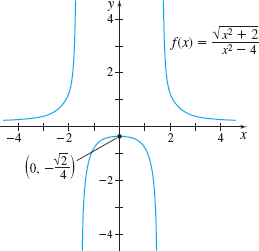EXAMPLE 2Determining Whether a Function Is Continuous at a Number
Determine if \(f(x)=\dfrac{\sqrt{x^{2}+2}}{x^{2}-4}\) is continuous at the numbers \(-2\), \(0\), and \(2\).

Solution The domain of \(f\) is \(\{x|x\neq -2\), \(x\neq 2\}\). Since \(f\) is not defined at \(-2\) and \(2\), the function \(f\) is not continuous at \(-2\) and at \(2\). The number \(0\) is in the domain of \(f\). That is, \(f\) is defined at \(0\), and \( f(0)=-\dfrac{\sqrt{2}}{4}\). Also, \begin{eqnarray*} \lim_{x\rightarrow 0}f(x)&=&\lim_{x\rightarrow 0}\frac{\sqrt{x^{2}+2}}{ x^{2}-4}=\frac{\lim\limits_{x\rightarrow 0}\sqrt{x^{2}+2}}{ \lim\limits_{x\rightarrow 0}(x^{2}-4)}=\frac{\sqrt{\lim\limits_{x\rightarrow 0}(x^{2}+2)}}{\lim\limits_{x\rightarrow 0}x^{2}-\lim\limits_{x\rightarrow 0}4 }\\[5pt] &=&\frac{\sqrt{0+2}}{0-4}=-\frac{\sqrt{2}}{4}=f(0) \end{eqnarray*}
The three conditions of continuity at a number are met. So, the function \(f\) is continuous at \(0\).
Figure 23 shows the graph of \(f\).